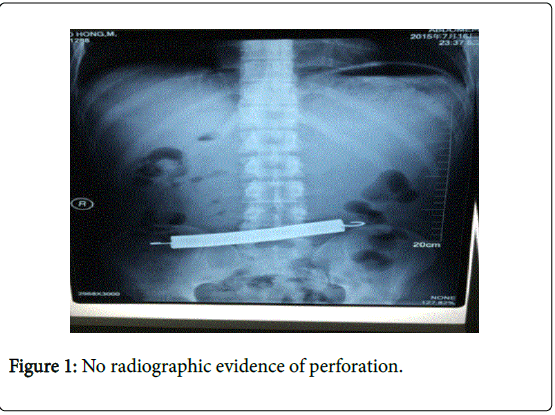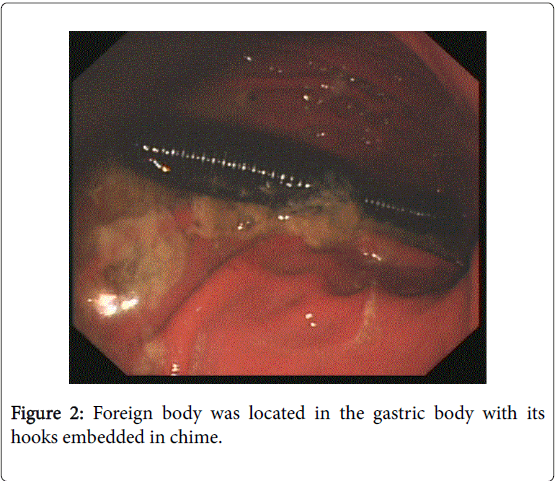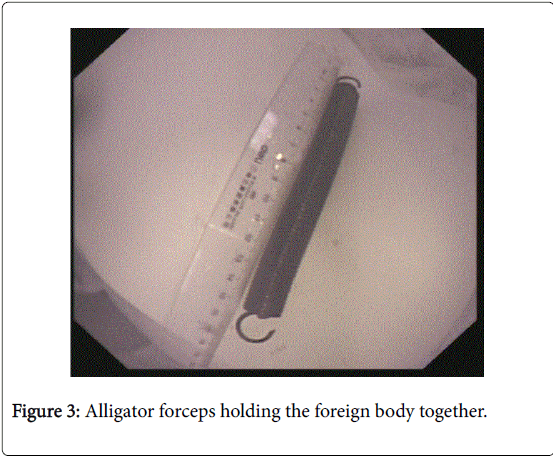Case Report Open Access
Lucky to Retrieve an Unusual Large Foreign Body by Endoscopy: A Case Report
Li Li, Wenhui Zhang, Jun Han, Xuemei Ma, Xinzhen Wang, Ying Liu, Bo Jin and Hanwei Li*Liver Cirrhosis Treatment and Endoscopy Center of 302 Military Hospital of China, Beijing, 100039, China
- *Corresponding Author:
- Han-Wei Li
Liver Cirrhosis Treatment and Endoscopy
Center of 302 Military Hospital of China
Beijing 100049, China
Tel: +86-13811568862
E-mail: 82722270@qq.com
Received date: January 05, 2016 Accepted date: January 15, 2016 Published date: January 25, 2016
Citation: Li L, Zhang W, Han J, Ma X, Wang X, et al. (2016) Lucky to Retrieve an Unusual Large Foreign Body by Endoscopy: A Case Report. J Gastrointest Dig Syst 6:380. doi:10.4172/2161-069X.1000380
Copyright: © 2016 Li L, et al. This is an open-access article distributed under the terms of the Creative Commons Attribution License, which permits unrestricted use, distribution, and reproduction in any medium, provided the original author and source are credited.
Visit for more related articles at Journal of Gastrointestinal & Digestive System
Abstract
Ingestion of foreign bodies that lodge in the upper gastrointestinal (GI) tract is a common clinical situation. A 34 year-old male who swallowed an unusual huge spring in a bet without any symptoms. There were no available endoscopic overtubes or devices for this kind of huge foreign object to protect the esophageal mucosa from laceration during the retrieval procedure. Fortunately, it was removed by endoscopy without severe complications. We present the case to arouse further concern about such as huge foreign bodies, how to be extracted more safely and less invasive.
Keywords
Foreign body; Endoscopy; Retrieval device; Overtube; Stomach
Introduction
Foreign bodies ingestions is a commonly encountered emergency in the endoscopic department. Most objects pass through the upper gastrointestinal (GI) tract spontaneously, but 10%-20% of ingested foreign bodies need endoscopic or surgical removal [1]. Here, we report an unusual large foreign object lodged in the stomach for nearly a week, which was safely removed by endoscopy fortunately.
Case Report
A 34 year-old single man with a history of drug abuse presented to the endoscopic center accompanied by his mother. He swallowed a huge spring with hooks which made him a winner of a bet with his friends on July 16, 2015. He had no complaints of abdominal pain, nausea, odynophagia, dysphagia, chest pain or reflux. He was at home until the bet was known by his mother five days later. He was taken to the hospital by his mother on July 22, 2015. On initial presentation, the patient talked little and denied any symptoms. Physical examination was normal except mild abdominal tenderness to moderate palpation without rebound tenderness or guarding. Laboratory results were normal except the positive anti-HCV. An electrocardiogram and the Xray of chest showed no abnormal signs. The abdominal plain radiography revealed a large spring with a hook at both ends in the stomach, which measured approximately 18cm X 2cm, and there was no radiographic evidence of perforation (Figure 1). CT scanning confirmed the unusual foreign body and showed no liver cirrhosis and esophageal varices. Considering the potential risks of the upper endoscopic procedure, including the possibility of esophageal and/or gastric perforation, mucosal injury and bleeding, the inability to retrieve the foreign body, the patient and his mother insisted on the decision to attempt the endoscopic removal of the spring and the written consent was signed by both the patient and his mother. The patient underwent a upper endoscopy under conscious sedation using propofol and sufentanil without endotracheal intubation. Cardiopulmonary function was monitored with pulse oximetry throughout the procedure. The foreign body was located in the gastric body with its hooks embedded in chime (Figure 2). After irrigation with the saline, the hook of the proximal end was exposed, which was easy to be grasped by the alligator forceps which was passed through the accessory channel. It was easy to pull the spring into the esophagus without obstruction, but it was difficult to pull out through the pharynx. After multiple attempts, it was finally retrieved with the endoscope and the alligator forceps holding the foreign body together (Figure 3).
On repeat endoscopic examination, minor mucosal injuries were found on the upper esophageal wall and pharynx without active bleeding. The patient refused to stay in the emergency room for further observation and left the hospital.
Discussion
Foreign objects ingestion occurs more commonly in the pediatric population,, which peaks in children aged six months to six years [2]. The ingestion of foreign bodies is rarely seen in adults, accounting for 20% of these emergencies, which generally accidental and commonly seen in the form of food (meat and bones) ingestion [3]. Patients who purposely swallow a true foreign body (nonfood object) typically are younger and more often male; associated psychiatric illness and/or drug abuse are common [4] The patient in this case admitted the history of drug abuse and may had a little depression which caused him to draw out the venous indwelling needle and refuse further observation after awake from the general anesthesia. Clinical presentations after foreign bodies’ ingestion depends on types and location of foreign bodies. Yao et al. [5] revealed that the most frequent symptomatic complaint after foreign bodies’ ingestion was odynophagia (36.5%). Most of the ingested foreign bodies were located in the upper esophagus. Thirty-four patients did not complain of any symptoms after foreign body ingestion and were classified as asymptomatic patients in contrast to symptomatic patients ( = 192). Among them, foreign bodies were most commonly located in the stomach and duodenum when found (17/34; 50%). The foreign body of this patient was very large (18cm X 2cm) with two hooks on the ends, but it was not sharp and located in the stomach,which resulted in none of symptoms for more than six days after ingestion. Although preendoscopic series have shown that 80% or more of the ingested objects are likely to pass spontaneously, in approximately 20% of cases, foreign bodies may require endoscopic or surgical intervention [6]. Judgment of the risks of aspiration, obstruction, or perforation determines the timing of endoscopy. Patients with esophageal obstruction, disk batteries and sharp-pointed objects in the esophagus require emergent endoscopy. Esophageal foreign objects that are not sharppointed or without complete obstruction and sharp-point objects or foreign body more than 6 cm in the stomach or duodenum need urgent endoscopy. In this case, the metal foreign object was too large to pass through the pylorus. There was only a little erosion on the surface of the gastric antrum without any significant ulcers or other complications. Because of the patient’s ignorance, the endoscopic procedure was achieved after nearly a week. There are many retrieval devices available, including rat-tooth and alligator forceps, polypectomy snares, polyp graspers, baskets, retrieval nets, magnetic probes, and friction-fit adaptors or banding caps [7]. An overtube or a retractable latex-rubber condom-type protector hood is recommended to protect the esophageal mucosa from lacerations during retrieval of sharp or pointed objects [8,9]. The diameter of the huge spring was approximately 2 cm, which was more than the diameter of the endoscopic overtube (US endoscopy 16.7mm) [10]. The Roth Net® maxi retriever is about 4 x 8cm, which is not large enough for this spring. Considering the size of the foreign body and risk of the lacerations, the patient was recommended to the surgery at first. But we attempted the endoscopy procedure under the family’s insistence and finally removed the huge spring without severe complications such as the esophagus or gastroesophageal junction injuries fortunately. In conclusion, it was lucky to retrieve this kind of unusual huge foreign object by endoscope. We propose this case to arouse further concern about conditions such as huge foreign bodies, how to be extracted more safely and less invasive.
References
- Guyatt GH, Oxman AD, Vist GE, Kunz R, Falck-Ytter Y, et al. (2008) GRADE: an emerging consensus on rating quality of evidence and strength of recommendations.BMJ 336: 924-926.
- UyemuraMC (2006) Foreign body ingestion in children. Am Fam Physician 73: 1332.
- Ginsberg GG (1995) Management of ingested foreign objects and food bolus impactions. GastrointestEndosc 41: 33-38.
- Webb WA (1995) Management of foreign bodies of the upper gastrointestinal tract: update. GastrointestEndosc 41: 39-51.
- Yao CC, Wu IT, Lu LS, Lin SC, Liang CM, et al. (2015) Endoscopic Management of Foreign Bodies in the Upper Gastrointestinal Tract of Adults.Biomed Res Int 2015: 658602.
- Ikenberry SO, Jue TL, Anderson MA, Appalaneni V, Banerjee S, et al. (2011)ASGE Standards of Practice Committee. Management of ingested foreign bodies and food impactions. GastrointestEndosc73: 1085-1091.
- Nelson DB, Bosco JJ, Curtis WD, Faigel DO, Kelsey PB, et al. (1999) ASGE technology status evaluation report. Endoscopic retrieval devices. February 1999. American Society for Gastrointestinal Endoscopy. GastrointestEndosc 50: 932-934.
- Tierney WM, Adler DG, Conway JD, Diehl DL, Farraye FA, et al. (2009)Overtube use in gastrointestinal endoscopy. ASGE Technology Committee, GastrointestEndosc 70: 828-834.
- Smith MT, Wong RK (2007) Foreign bodies. GastrointestEndoscClin N Am 17: 361-382.
- Swaminath A, Lucas AL, Capiak K, Sethi A, Garcia-Carrasquillo R (2010) A foreign body larger than the overtube diameter: a case of a large cow foot bone causing esophageal impaction. GastroenterolHepatol (N Y) 6: 793-795.
Relevant Topics
- Constipation
- Digestive Enzymes
- Endoscopy
- Epigastric Pain
- Gall Bladder
- Gastric Cancer
- Gastrointestinal Bleeding
- Gastrointestinal Hormones
- Gastrointestinal Infections
- Gastrointestinal Inflammation
- Gastrointestinal Pathology
- Gastrointestinal Pharmacology
- Gastrointestinal Radiology
- Gastrointestinal Surgery
- Gastrointestinal Tuberculosis
- GIST Sarcoma
- Intestinal Blockage
- Pancreas
- Salivary Glands
- Stomach Bloating
- Stomach Cramps
- Stomach Disorders
- Stomach Ulcer
Recommended Journals
Article Tools
Article Usage
- Total views: 12404
- [From(publication date):
February-2016 - Feb 03, 2025] - Breakdown by view type
- HTML page views : 11653
- PDF downloads : 751



